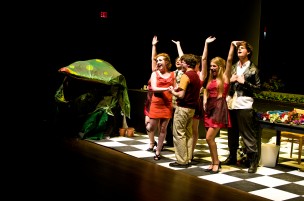
Quick, what’s big, green, sings, and consumes human flesh? If you answered, “An alien plant that invaded during the ’60s,” you probably witnessed last weekend’s Second Stage production of “Little Shop of Horrors,” the bizarre musical hit written by Alan Menken and Howard Ashman and staged at Wesleyan by directors Jenna Robbins ’13 and Jiovani del Toro Robles ’13. “Little Shop” is a crowd-pleaser, a silly show that has no aspirations of being anything more (its atmosphere puts one in the mind of the perennial “Rocky Horror Picture Show”). Under the direction of Robbins and Robles, this production delivered on that promise despite some technical hiccups.
Our guides, with penchants for Earth slang, through the world of man-eating plants were three “Doo-Wop Girls,” identified in the program as Ronette, Crystal, and Chiffon. Portrayed respectively by Linsin Smith ’16, Beanie Feldstein ’15, and Sara Guernsey ’15, the trio led us through a Rocky Horror-esque prologue and into the action of the story, providing backing vocals for other songs. Their three-part harmonies were some of the most delightful moments of the show: Guernsey in particular (often taking the lead) was powerful, Feldstein has proven consistently excellent this season, and newcomer Smith easily held her own in the lineup.
In fact, the vocal work on the cast’s part was uniformly excellent (congratulations are due to music director Matt Leibowitz ’14). The standout among the leading characters was easily Trina Parks ’15 as Audrey, the long-suffering love interest. Abused by her boyfriend and broke, Audrey is undoubtedly a victim, but Parks’ performance brought the role a self-awareness and earnestness that rounded out what could easily have turned into a caricature. She also managed to pull the perfect amount of city-girl inflection into her vocal lines without straying too far into twang, letting her dulcet tone shine.
As her boyfriend, the abusive dentist Orin, Nick Martino ’15 was appropriately menacing and managed to balance real violence with character comedy in a refreshing way. Although it’s an old bit, a second-act song that involved Martino’s repeated return in different costumes (including drag) was also very successful. Another strong comedian was Ben Zucker ’15 as Mr. Mushnik, the scheming proprietor of the floral shop where Audrey and schmuck protagonist Seymour work. Although Zucker sometimes struggled with his music (Mushnik has a lot of complex patter), his comedic timing and character work were excellent.
Jacob Feder ’15 played Seymour, the hapless florist protagonist who stumbles upon the carnivorous plant and tries to use it to gain fame, fortune, and (most importantly) Audrey’s love. The role showcased Feder’s strong voice, and his stuttering, closed-off but eager-to-please performance fitted the nebbish Seymour of the show’s beginning to a tee. Sadly, this strong early performance led to disappointment near the end of the show: as the plant, dubbed “Audrey II,” begins to take over more and more of Seymour’s life and pushes him into murder, our charming protagonist begins to lose his mind, a casualty to the battle of wills between him and his pet. This was a transformation I never quite believed, with the feeling of a man gesturing at desperation rather than engulfed in it. Previously, the actor’s timidity had been a welcome choice; in the play’s final life-or-death stakes, it became a hindrance.
Overall, though, the performances and particularly the vocal acrobatics were strong despite (on the night I witnessed, at least) some disappointing technical difficulties. Balancing the acoustics of full band and live singers in the ’92 Theater is a perennial challenge, and no production, including this one, has quite yet managed it. Although there were many problem spots, the most consistently hampered was Dan Storfer ’15, who provided the voice for Audrey II (the puppets were capably manipulated by Feder and Regen Routman ’16). Storfer’s performance was delicious when audible, and his dialogue scenes were often hilarious, but some of his songs lacked punch; Audrey II’s first number, “Feed Me (Git It),” includes rapid-fire patter that was nigh impossible to follow. (It should be noted for the record that Storfer also played a number of cameo parts, consistently excellent.)
The unusual choice to leave the actors’ microphones on even during the dialogue was also jarring at first, and I never quite got used to hearing the voice of an actor on the left hand side of the stage coming from the speaker to my right. On the other hand, the set by Tavo True-Alcalá ’15 was strong without being ostentatious, and the lighting by Natalia Powers-Riggs ’13 did a more-than-capable job of turning on the glitz and glam attendant to this classic musical.
If you were looking for an evening of powerful, moving drama, “Little Shop” was probably a disappointment. But with its quirky humor, sometimes dipping a toe into taboo (my favorite line was Seymour’s claim that Audrey must be a nice girl, “Deep down, under the bruises…and handcuffs…”), the musical was a wonderful evening of entertainment for entertainment’s sake, and well worth the time spent to enjoy it.


Leave a Reply